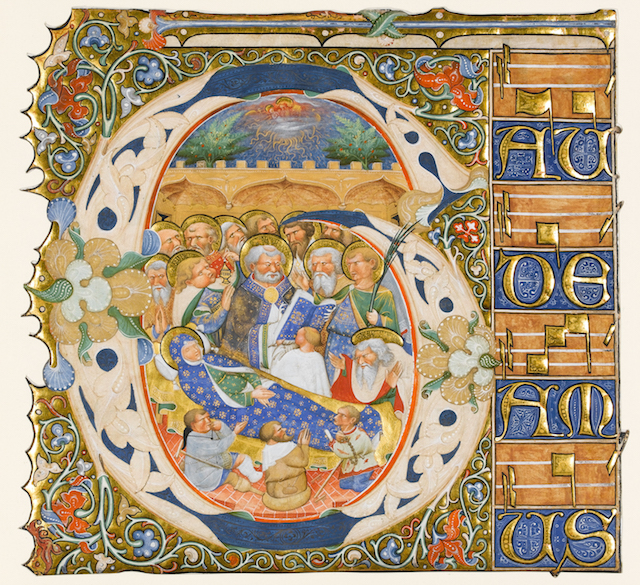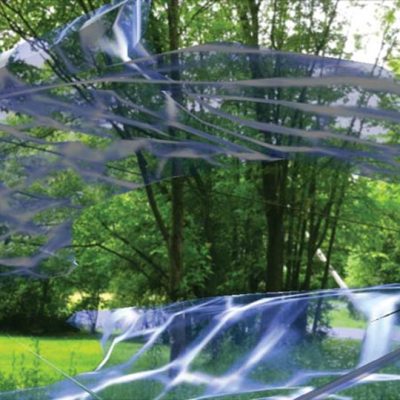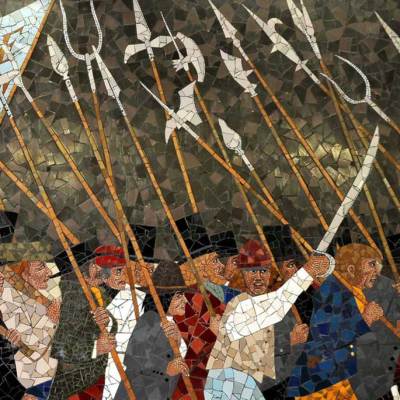‘Illumination’, from the Latin illuminare, means the bringing of light. The term was originally restricted to the use of gold within manuscripts and meant not the supply of images to accompany text, but capturing light on the page. It is paradoxically apt, then, that the first impression on entering the Fitzwilliam’s wonderful exhibition, ‘Colour’ (until 2 January 2017), is of darkness. The dimness is obviously necessary for the preservation of the artefacts displayed, but it also serves a less practical purpose: the illuminations glowing in their cases seem themselves the source of light.
The exhibition encourages us to think of these manuscripts as harbours of colour, treasuries in which gold, vermilion, and cochineal have been happed in darkness, persisting while the depredations of time and iconoclasm have compromised the more obvious repositories of paintings, sculpture, and stained glass. ‘Colour’ marks the Fitzwilliam’s bicentenary and draws attention to some of its rarely exhibited treasures; the museum’s collection of books and manuscripts is less well known than its art and objects. Textual artefacts were however central to the 7th Viscount Fitzwilliam’s benefaction, which established the museum in 1816, and the collection ranges from domestic prayerbooks and books of hours, through ecclesiastical pontificals and processionals, to the technical manuals and model books of Italian artists, and the best extant Ripley scroll, an illustrated alchemical poem. Alongside early British books, such as the Peterborough and Macclesfield Psalters, and the Pabenham-Clifford Hours, the exhibition shows much European material (including the late 10th-century Reichenau Epistolary, sumptuous Parisian exemplars from the late 13th century, and early Italian humanist works), and some Ottoman, Persian, and Tibetan illuminations, too. As well as presenting a rare opportunity to encounter these works, ‘Colour’ encourages us to see differently: to consider anew the role of illumination in the history of art, and the nature of colour.
The Anointing of David from the Macclesfield Psalter (c. 1330–40), England, East Anglia, probably Norwich. Fitzwilliam Museum, Cambridge

Taking colour as the subject of the exhibition is imaginative and stimulating, focusing attention on the surface of the illuminations, the stuff from which they are made, the illuminators’ achieved effects, and questions both physical and metaphysical about vision. The curators point out that, in medieval considerations of colour, it is not only hue that matters, but also luminosity and intensity; and in doing so, they make primary the experience of standing in front of these images and looking. Though the catalogue that accompanies the exhibition is wonderfully rich in essays on multiple contexts of the items displayed, and generously illustrated, it can only underscore the necessity of taking in the vibrancy of these colours in one’s own eye.
Treating colour as something that can be stored and curated illustrates a difference between modern and medieval understandings. While scientific thinkers of the 17th century demoted colour to a secondary quality, for the illuminators whose work is displayed here, it was understood not as an effect of the absorption of light by a surface, but as the primary object of the eye’s attention, the basis of sight, and an essential property of things. This earlier and more substantial understanding of colour as ‘light embodied’, in the words of the medieval theologian Robert Grosseteste, is underscored in the exhibition and catalogue’s concern with the sources of paints and dyes. In preparing colours for application to parchment, solid bodies had to be ground, beaten, or scraped. One of the first cases displays materials from which pigments were obtained: murex shells, the red pods of the kermes insect, a scintillating heap of verdigris, a sooty pile of carbon blacks. The works displayed here convene the animal, vegetable, and mineral, incorporating plant extracts, ground insects, crushed stones, scrapings of metals, all on a ground of stretched animal skin.
The focus on materials also emphasises the place of colour in a global economy, and makes the page a place where continents meet. For artists working in monasteries around the British isles, for example, illumination would bring together local English woad with exotic stuffs, whose names often recalled their origins: Polish cochineal, Armenian reds, Tyrian purple hauled from the Mediterranean, cinnabar from Sinope, indigo from India, and from Afghanistan, the fabulously expensive dust of lapis lazuli, called ultramarine for its origins beyond the sea. As colours were named for places, so places for colours. Saffron Walden is so called for its cultivation of crocuses, used for yellows, and Brazil gains its name from South America’s plentiful stock of brazilwood, a source of rich reds: lignum brasilium means wood which glows like embers. These pages are deposits of global history: in the early 12th century, after the First Crusade, for example, vermilion and ultramarine became more common in Christian manuscripts as it became easier to import them from Asia; the Venetian works displayed here owe their vibrancy to the city’s role as a mercantile hub.
Dormition of the Virgin (c. 1420), Master of the Murano Gradual. © Fitzwilliam Museum, Cambridge

The exhibition, and its accompanying catalogue and ‘Illuminated’ website, have purposes beyond eliciting the gasps of viewers dazzled by the vividness and luxury of these artefacts. A central claim is that illuminations are an underutilised source of information about colour, paint, and painting techniques in the medieval period – indeed the best available resource. One polemical aim of the catalogue is to challenge the 19th-century hierarchy that saw developments in monumental and panel-based works as the evolving story of Western painting, while illumination, understood as monkish and monastery-confined, was seen as minor, conservative, and irredeemably medieval. The curators and authors instead emphasise creativity, innovation, and experiment. Assumptions of periodisation are disturbed by indications of how illuminators’ washes anticipate Turner’s renderings of sky, or how colour-contrast implies the position of bodies beneath folds of cloth before monumental painting achieved such modelling, or passages of pointillism avant la lettre.
A further purpose is testifying to the possibilities of scientific investigation. As part of MINIARE, a long-term collaborative project of which this exhibition is the culmination, novel methods of non-invasive analysis were developed to identify the chemical composition of colour and the techniques of artists. Both catalogue and website illustrate mantic machines poised over the page to read the colours’ spectral vibrations – a technological intervention that intensifies attention to the making, matter, and meaning of these images. Fascinating details emerge – an illuminator’s experiments with new materials and colours in the course of a single book; a master’s instructions for colour and technique to his workshop, concealed beneath the painted surface; layered washes to give effects of skin, lending warmth and light to flesh in imitation of the incarnation. The collaboration of modern scientists, librarians, curators, and scholars mirrors the scrupulous and skilful practices of colour-grinding and application practiced in the medieval scriptorium and workshop, in ways which bring more light to bear on these already luminous objects.
From the October issue of Apollo. Preview and subscribe here.



